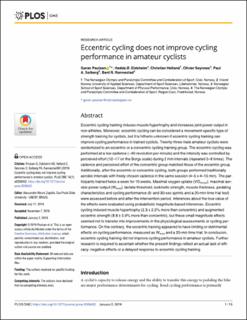| dc.contributor.author | Paulsen, Gøran | |
| dc.contributor.author | Eidsheim, Hedda | |
| dc.contributor.author | Helland, Christian | |
| dc.contributor.author | Seynnes, Olivier R. | |
| dc.contributor.author | Solberg, Paul André | |
| dc.contributor.author | Rønnestad, Bent | |
| dc.date.accessioned | 2020-03-19T17:33:01Z | |
| dc.date.available | 2020-03-19T17:33:01Z | |
| dc.date.created | 2019-05-21T10:33:14Z | |
| dc.date.issued | 2019 | |
| dc.identifier.citation | PLoS ONE. 2019, 14(1), e0208452. | en_US |
| dc.identifier.issn | 1932-6203 | |
| dc.identifier.uri | https://hdl.handle.net/11250/2647647 | |
| dc.description | This is an open access article distributed under the terms of the Creative Commons Attribution License, which permits unrestricted use, distribution, and reproduction in any medium, provided the original author and source are credited. | en_US |
| dc.description.abstract | Eccentric cycling training induces muscle hypertrophy and increases joint power output in non-athletes. Moreover, eccentric cycling can be considered a movement-specific type of strength training for cyclists, but it is hitherto unknown if eccentric cycling training can improve cycling performance in trained cyclists. Twenty-three male amateur cyclists were randomized to an eccentric or a concentric cycling training group. The eccentric cycling was performed at a low cadence (~40 revolution per minute) and the intensity was controlled by perceived effort (12–17 on the Borgs scale) during 2 min intervals (repeated 5–8 times). The cadence and perceived effort of the concentric group matched those of the eccentric group. Additionally, after the eccentric or concentric cycling, both groups performed traditionally aerobic intervals with freely chosen cadence in the same session (4–5 x 4–15 min). The participants trained twice a week for 10 weeks. Maximal oxygen uptake (VO2max), maximal aerobic power output (Wmax), lactate threshold, isokinetic strength, muscle thickness, pedaling characteristics and cycling performance (6- and 30-sec sprints and a 20-min time trial test) were assessed before and after the intervention period. Inferences about the true value of the effects were evaluated using probabilistic magnitude-based inferences. Eccentric cycling induced muscle hypertrophy (2.3 ± 2.5% more than concentric) and augmented eccentric strength (8.8 ± 5.9% more than concentric), but these small magnitude effects seemed not to transfer into improvements in the physiological assessments or cycling performance. On the contrary, the eccentric training appeared to have limiting or detrimental effects on cycling performance, measured as Wmax and a 20-min time trial. In conclusion, eccentric cycling training did not improve cycling performance in amateur cyclists. Further research is required to ascertain whether the present findings reflect an actual lack of efficacy, negative effects or a delayed response to eccentric cycling training. | en_US |
| dc.language.iso | eng | en_US |
| dc.subject | torque | en_US |
| dc.subject | strength training | en_US |
| dc.subject | muscle analysis | en_US |
| dc.subject | heart rate | en_US |
| dc.subject | human performance | en_US |
| dc.subject | blood | en_US |
| dc.subject | exercise | en_US |
| dc.subject | sports | en_US |
| dc.title | Eccentric cycling does not improve cycling performance in amateur cyclists | en_US |
| dc.type | Peer reviewed | en_US |
| dc.type | Journal article | en_US |
| dc.description.version | publishedVersion | en_US |
| dc.rights.holder | © 2019 Paulsen et al. | en_US |
| dc.source.pagenumber | 15 | en_US |
| dc.source.volume | 14 | en_US |
| dc.source.journal | PLoS ONE | en_US |
| dc.source.issue | 1 | en_US |
| dc.identifier.doi | 10.1371/journal.pone.0208452 | |
| dc.identifier.cristin | 1699006 | |
| dc.description.localcode | Seksjon for fysisk prestasjonsevne / Department of Physical Performance | en_US |
| cristin.unitcode | 150,31,0,0 | |
| cristin.unitname | Seksjon for fysisk prestasjonsevne | |
| cristin.ispublished | true | |
| cristin.fulltext | original | |
| cristin.qualitycode | 1 | |
